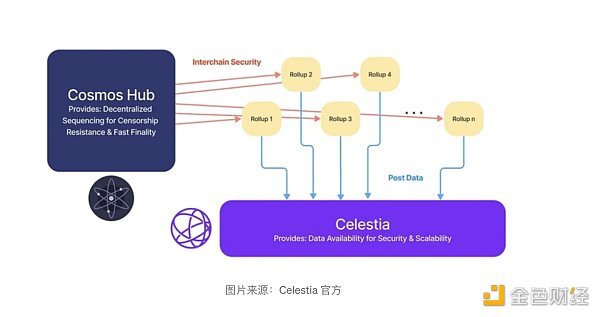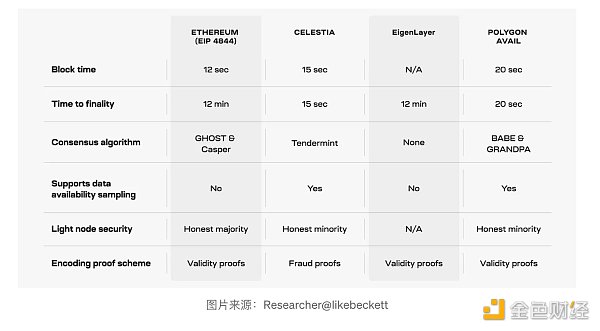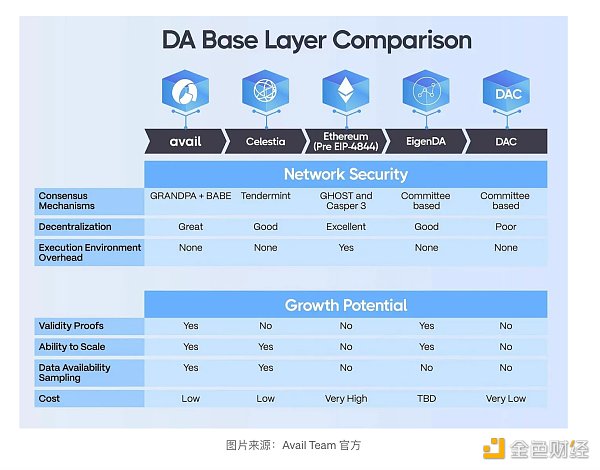Author: Ac-Core, YBB Capital Translation: Shan Ouba, Golden Finance
Foreword
According to the definition of the Ethereum Foundation, Layer 2 of Ethereum is equal to Rollup. Vitalik's recent new view is that if other EVM chains use non-Ethereum as the data availability (DA) layer, it belongs to Ethereum Validium (moving the blockchain's data availability layer off-chain). Although the exact definition of Layer 2 is still somewhat controversial due to DA issues, Ethereum’s upgrade route is still centered on Rollup, and data availability plays a key role in saving or uploading Rollup transaction data in Ethereum upgrades. ZK Rollup accesses related data through the data availability layer, even if the degree of dependence is different, it will affect their own security to a certain extent. In the face of Cosmos shared security innovation, Celestia's data availability penetration, and market maker-driven markets, can EigenLayer regain market dominance with its native Ethereum lending functionality by elevating middleware to an Ethereum-level security narrative?
EigenLayer

Simply understand, EigenLayer is a Re-stake protocol based on Ethereum, which provides the entire The future crypto-economy based on Ethereum provides Ethereum-level security. It allows users to re-stake native ETH, LSDETH and LP Token through EigenLayer smart contracts and obtain verification rewards, allowing third-party projects to obtain more rewards while enjoying the security of the ETH main network, thus achieving a win-win situation.
The reason why Ethereum is able to attract a lot of trading volume and liquidity is that it is currently recognized by most people as the most secure after Bitcoin Layer 1 blockchain, and EigenLayer directly connects to Ethereum’s security and liquidity through Actively Validated Services (AVS), essentially delegating the security verification of its token model directly to Ethereum. Its essence is to directly entrust the security verification of its tokens to Ethereum nodes (which can be simply understood as node operators). This process is called "Re-stake". In this article, we only cite the first AVS project developed by the EigenLayer team: EigenDA.
EigenDA: Aggregated data availability

According to the official explanation and introduction (there is currently no actual relevant data support ), EigenDA is a decentralized data availability (DA) service built on Ether using EigenLayer Restake, and will be the first Active Validation Service (AVS) intrinsic layer. Restakers can delegate staking to node operators executing EigenDA, perform verification tasks, and receive service fees in return, while Rollups can publish data to EigenDA to reduce transaction fee costs, achieve higher transaction throughput, and improve the overall Security of the EigenLayer ecosystem. The security and transaction throughput of this development process will scale with the overall growth of staking volume, related ecological protocols, and operators.
EigenDA aims to provide Rollups with an innovative DA solution that allows Ethereum stakers and validators to connect to each other, improving security while increasing throughput and To reduce costs, the EigenLayer shared security system uses a multi-node approach to ensure decentralization. According to EigenDA, its integrated Layer2 solutions include Celo, which transitions from L1 to Ethernet L2; Mantle and its supporting products outside the BitDAO ecosystem; Fluent, which provides the zkWASM execution layer; Offshore, which provides the Move execution layer; and Optimistic OP stack. Currently used on the EigenDA test network).
EigenDA is a secure, high-throughput, decentralized data availability (DA) service built on Ether based on EigenLayer Restake. Here are some of the main features and benefits EigenDA aims to achieve:
Features:
Shared security: EigenDA leverages EigenLayer's shared security model to enable Retakers to participate in the verification process by contributing ETH, improving the overall security of the network;
Data Availability: EigenDA's primary goal is to ensure data availability on Layer 2 networks. It uses validators to verify and guarantee the validity of data on the Rollup network, prevent bad behavior and ensure the normal operation of the network;
Go Centralized sorting: EigenDA uses EigenLayer's decentralized sorting mechanism to ensure that transactions in the Rollup network are executed in the correct order, thereby maintaining the correctness and consistency of the entire system;
-
Flexibility: EigenDA is designed to allow L2 developers to adjust various parameters as needed, including trade-offs between security and liveness, staking token modes, correction Coding ratio, etc. to adapt to different scenarios and needs.
Advantages:
Economic benefits: EigenDA realizes the sharing security of ETH through EigenLayer, thereby reducing potential staking costs. Provide more cost-effective verification services by decentralizing data verification efforts and reducing operating costs for each operator;
High throughput Volume: EigenDA is designed to scale horizontally, increasing its throughput as more operators join the network. In private testing, EigenDA has demonstrated throughput of up to 10 MBps, with a roadmap for expansion to 1 GBps, opening up the possibility of supporting high-bandwidth applications such as multiplayer gaming and video streaming;
Security mechanism: EigenDA adopts a multi-layer security mechanism, including EigenLayer's shared security, custody certification mechanism and dual arbitration to ensure network security and decentralization customizable and censorship-resistant;
Customizability: EigenDA provides a flexible design that allows L2 developers to Requirements and use cases adjust various parameters to find a balance between security and performance.
Re-pledge mode

Applicable to independent ETH pledgers, they can withdraw through The voucher points the staked ETH to the EigenLayer smart contract to re-stake and earn additional income. If the independent pledger commits misconduct, EigenLayer can directly lose its withdrawal certificate;
LST (Liquid Stake Token) represents liquid staking token. Even if ordinary investors do not have 32 ETH, they can "carpool" through liquidity staking protocols such as Lido and Rocket Pool, deposit their ETH into the pledge pool, and obtain the commitment of LST representing their ETH and income claim rights. Users who have pledged ETH in Lido and Rocket Pool can transfer their LST holdings to the EigenLayer smart contract to achieve additional returns by staking again;
LP token deposit The deposits are divided into ETH LP deposits and LST LP deposits.
ETH LP re-pledge: Users can re-pledge a pair of DeFi protocols containing ETH to EigenLayer LP tokens.
LST LP re-pledge: Users can re-pledge a pair of DeFi protocol LP Token containing lsdETH to EigenLayer. For example, Curve protocol’s stETH-ETH LP Token can be re-pledged to EigenLayer.
Celestia in Cosmos

There is currently no blockchain that can truly solve the impossible triangulation problems of decentralized, secure and scalable blockchains. Cosmos believes that only a multi-chain design architecture can overcome them to a certain extent. trade-off between. Before discussing Celestia, let’s briefly review Cosmos, where blockchains achieve interoperability through the IBC (Inter-Blockchain Communication) protocol. The security between Cosmos chains is discussed in detail below:
IBC protocol security: IBC is a protocol that ensures communication between chains in the Cosmos network. It ensures the confidentiality and integrity of messages through encryption, signature and other mechanisms. The IBC protocol includes a series of authentication steps to ensure the trustworthiness of inter-chain communications. Through IBC, the Cosmos chain can safely transmit messages and assets to prevent fraud and tampering;
Consensus mechanism security: Each blockchain in the Cosmos ecosystem may Different consensus mechanisms are used, the most common of which is Tendermint. The Tendermint consensus algorithm ensures consistency between nodes through Byzantine Fault Tolerance (BFT). This means that the system can still function normally in the presence of a certain number of malicious nodes. The security of the consensus mechanism is crucial to the stability and security of the entire network;
Hub security: There is a centralized blockchain Hub in the Cosmos network , which acts as a bridge between different chains. The security of the Hub plays a key role in the stability of the entire ecosystem. If the Hub is not secure, it may cause problems throughout the network. Therefore, ensuring the security of the Hub is an important task in the Cosmos ecosystem, involving strict control of its consensus mechanism and node management;
Asset security: due to Assets can be transferred between Cosmos chains, so ensuring their security is crucial. By using cryptography, the Cosmos chain is protected against malicious activities such as double-spend attacks. At the same time, the IBC protocol aims to make cross-chain asset transfers safe and reliable;
Smart contract and application layer security: The Cosmos network allows the development of smart contracts and distributed app. Ensuring this level of security is achieved by ensuring code quality, auditing, and bug fixes for smart contracts and applications running on the blockchain.
Celestia achieves scalability and flexibility through a modular design that separates consensus and execution, providing customizable solutions for a variety of blockchain solutions. ecosystem. In contrast, Cosmos promotes blockchain collaboration in an ecosystem-neutral manner, emphasizing interconnectivity between independent blockchains, and using Tendermint to integrate consensus and execution to provide a cohesive environment, which intuitively brings the negative impact of losing one’s own flexibility. Celestia's modular approach provides enhanced scalability, development flexibility and customized solutions to meet the needs of different applications. Some people call for Celestia+Cosmos to become the ultimate form of future application chains.
Celestia's ICS and EigenLayer's EigenDA

However, it is the recent proposal in Celestia that deserves attention ICS (Interchain Security) is mentioned in , instead of EigenLayer, EigenLayer is a data availability layer built on top of Ethereum, and some contrasting aspects of ICS and EigenLayer, and the relationship between them can be understood in the following way:
Shared Security: Celestia’s proposal discusses using ICS to use validators in the Cosmos ecosystem ( For example, the possibility of validators in Cosmos Hub) acting as Celestia's Rollup sequencer. This approach will allow multiple Rollup networks to share the same set of validators, thereby achieving shared security. The idea is somewhat similar to the idea of shared security in EigenLayer, as both provide security by leveraging validators of the underlying blockchain network. The difference is that ICS uses Cosmos Hub’s validators to provide verification services for connected blockchains, improving the security of the entire ecosystem through a shared security model, while EigenDA provides verification services through EigenLayer on Ethereum, which uses ETH’s The validator verifies the data availability of the Rollup network;
Decentralized sequencer: The decentralized sequencer mentioned by Celestia The sequencer concept takes advantage of the ICS approach. This is somewhat similar to using EigenLayer's Restake Primitive (repledge mechanism) in EigenLayer to build a decentralized sorter. Both attempt to achieve a more decentralized sorting mechanism through the properties of the underlying protocol;
Rollups composability: Celestia mentioned that cross-Rollup composability can be achieved by using the same sequencer in multiple Rollup networks (possibly via ICS). This is somewhat similar to the goal mentioned in EigenLayer. It is hoped that multiple AVS (Active Verification Services) in the EigenLayer ecosystem will cooperate with each other to achieve a higher level of composability and interoperability;
Economy: Putting aside the technical aspects of Celestia and EigenLayer, from a market perspective, users are more concerned about their own profits, and EigenLayer’s points in LST Benefits such as layer income stack and other aspects are slightly stronger than Celestia. The expected value of future airdrops for the entire EigenLayer ecosystem.
Comparison between DA layers

Data Availability (DA ) referred to as DA. Currently, in the EtherChannel upgrade route, the entire process is mainly based on Rollup, and the role of DA in this process is to save or upload all transaction data of the entire Rollup. The emergence of Rollup is to solve the problem of scalability Layer 1, but actually accessing Layer 2 data through DA will affect the overall security and TPS level. Layer 2 data will affect the overall security and TPS level. In order for Layer 2 to inherit the security of Ethernet, Ethernet needs to optimize the entire protocol security mechanism to upload a large amount of Layer 2 data.
In the consensus mechanism, there is a fundamental dilemma, namely effectiveness and security. The former ensures the rapid processing of transactions, and the latter ensures the accuracy of transactions. and security, for which different blockchain systems will make different choices to achieve a balance that meets their actual needs. Ethereum, Celestia, EigenLayer, and Avail solutions are all designed to provide scalable data availability for Rollup, which I summarize below based on data provided by Researcher@likebeckett and Avail.

p>
Celestia:
Go Centralized Orderer Proposal: Celestia discussed a proposal from COO Nick White to implement Celestia’s decentralized orderer using the Cosmos ecosystem’s Interchain Security (ICS) as a way to leverage the Cosmos Hub verification A way for the server to provide shared security to the DA layer through ICS. Atomic composability across Rollups: Celestia Improve composability by using ICS to implement atomic transactions across multiple Rollup networks. The same sequencer enables multiple Rollup networks to work together, solving dispersed mobility and reduced composability;
Multiple Rollup Interoperability: Using the same sequencer, Celestia facilitates interoperability between multiple Rollup networks for better mobility and data availability.
EigenLayer and EigenDA:
Data availability service with shared security: EigenLayer provides data availability services through EigenDA. Unlike traditional blockchains, EigenDA is a set of smart contracts built on Ethereum, utilizing The concept of shared security. EigenDA can serve as part of the Celestia ecosystem, providing efficient, secure, and scalable data availability;
Decentralized sorting: ;EigenLayer emphasizes its decentralized sorting mechanism, which essentially adds ETH tokens and penalties to the PoS process of the Rollup sorter, providing higher security for the Layer 2 network. Through this mechanism, EigenLayer implements an efficient sorting process;
Data availability service: EigenDA focuses on serving the second-layer network Provide data availability services and provide high-performance data transmission for on-chain applications through EigenLayer's shared security and decentralized sorting.
Useful.
Data availability design: Avail focuses on data availability design and introduces data availability Sampling techniques. This technology allows light nodes to verify data availability by downloading only a small portion of a block, rather than relying on the entire node to obtain the data, thereby improving the scalability of the network;
Interaction between blockchains: Avail aims to improve the interaction between blockchains. Light nodes that support data availability sampling can increase block size more flexibly and improve overall throughput;
EIP 4844 adapts to: Avail is actively involved in the implementation of Ethereum EIP 4844, a key component of Polygon's modular blockchain vision, a proposal to increase block sizes and lay the foundation for the implementation of Danksharding, allowing Avail to adapt to upgrades in in the Ethereum ecosystem.
Conclusion
For Rollup, in the past 24 years , in addition to the narrative certainty brought by the Cancun upgrade, the DA issue debate also brought doubts about the precise positioning of Layer 2. Putting aside for the time being the orthodoxy, security, and cost issues faced by the actual availability of Ether data, this dispute between Celestia vs. EigenDA can easily lead to a question: Will the confrontation between Ether Killer and Ether Protector lead to more market competition in the future? Developing in the direction of composable modules will lead to a new round of expansion of Ethereum.
Although the blockchain itself has many limitations, from the perspective of financial markets, a large part of the upward momentum of all markets comes from the "hypothesis space" , this space always needs fresh stories to feed. As far as innovation itself is concerned, in addition to maintaining its own correctness, "branch" is also a narrative direction outside the original framework.
 JinseFinance
JinseFinance
 JinseFinance
JinseFinance JinseFinance
JinseFinance JinseFinance
JinseFinance JinseFinance
JinseFinance Huang Bo
Huang Bo JinseFinance
JinseFinance JinseFinance
JinseFinance Bitcoinist
Bitcoinist Cointelegraph
Cointelegraph Bitcoinist
Bitcoinist